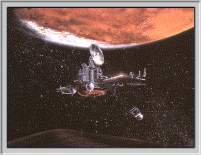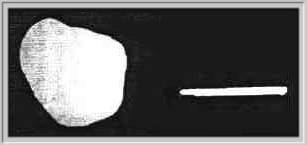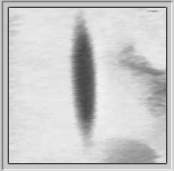The Soviet Phobos 2 probe was sent to examine the Martian moon Phobos (The USSR was interested in the possibility of using Phobos as a staging post for a manned exploration of Mars)
Maybe one of the mission's goal was to find more about the strange chain craters on Phobos? (January 1977 issue of 'Astronomy' author anonymous).
On March 28, 1989, Russian ground controllers suddenly and unexpectedly lost contact with their Phobos 2 probe. The very last close-up infrared photo of Phobos snapped by the spacecraft shows 'an object which shouldn't have been there'.

The Phobos Mystery Object (PMO) as it was referred to was soon believed to be a UFO by some. It was also speculated that the Russian mission had been deliberately terminated by aliens unwilling to let Phobos 2 approach the moon, supposed to be an artificial avant-poste of alien visitors on their way to earth. This scenario fit with the other mysteries: the supposed hollow nature of the moon suggested by its strange gravitational behaviour, its strange closeness to the Martian surface, its visionary discovery by Jonathan Swift, the failure of Hershell and others to discover it and the sudden discovery by Hall that suggested it was not there before, the failure of Phobos 1, and all the other more famous Martian mysteries.
The final infrared picture photo of Phobos occurred just three days before the communication failure, it reveals the outlines of both Phobos and the PMO. All surface detail is washed out on both objects which is very common in infrared pictures.

If the PMO was at the same distance as Phobos itself, it would be about 2 kilometers wide and 20 long. Its surface brightness is the same as that of Phobos. The sides of the PMO are perfectly parallel; it is rounded at both ends; the end towards Phobos narrows slightly; the other end seems to have a slight protrusion. An attempt to explain the presence of the object was that...
...since the PMO does not appear to have a metallic surface and displays no antennas or other indicators of artificiality, it is reasonable to ask whether it might be some natural phenomenon. One possibility is that the PMO image is only a "trailed moonlet;" that is, the smeared image of a small piece of debris also in orbit about Mars but moving at a slightly different velocity from that of the spacecraft and Phobos. Since the exposure time of the last photo was 8 seconds, a smeared image due to the PMO's relative motion is reasonable.
(Anonymous; "Mystery Object Encountered by Russian Phobos Spacecraft," Meta Research Bulletin, 1:1, March 15, 1992.
This new newsletter, edited by astronomer T. Van Flandern, focusses on astronomical anomalies. Address: P.O. Box 15186, Chevy Chase, MD 20815.)
Of course one wonder why a UFO should have an antenna, and why an antenna -a thing supposed to be rather small- should be seen on an infrared photo blurred enough not to reveal the Phobos craters properly.
One can also suppose that a smeared image of a moving debris would result in a regular trail, not a trail with a narrow beginning, a long enlargement and a slightly widened head. Unless maybe the debris changed speed inside the 8 seconds exposure, which would raise more questions.
Then, If it is not a trail, the elongated shape would be a sufficient indicator of artificiality or at least strangeness.

Actually there is a second strange Phobos 2 photo, an elongated shadow on the Martian surface, that was considered as an UFO shadow by some. It is certainly a source of great confusions when rational explanations are provided on this photo while the other is ignored and vice-versa.
Cover-up? here is the personal report of a Canadian citizen who witnessed the event broadcasted on national TV in Canada. A very valuable report indeed as far as both the Phobos 2 strage evenrs, and media attitude towards strange events, are both considered.
The NASA 'Mars Observer' was launched from Cape Canaveral in late 1992, on a 337 day voyage to Mars to photograph Mars and its moons. The Mars Observer initially was expected to arrive at Mars by 19 August 1993 and enter a long, elliptical orbit over the poles. In mid November 1993 it was to begin its two year mapping of the surface of Mars. Then suddenly, on 22nd August 1993, NASA lost contact with the spacecraft.
Americans and the world mourned the loss of a valuable scientific tool for understanding Mars. Taxpayers wondered if there was a better way to spend their money than on expensive space probes that didn't work. After this failure and the previous failures, it was generally felt that a dark shield was going up on new information about Mars to the public at large.
(Phobos Information/Data from NASA -NSSDC)
Launch: 07 July 1988 (Phobos 1) and 21 July 1988 (Phobos 2)
Vehicle: Proton-K.
Mass: 2600 Kg (6220 Kg with orbital insertion hardware attached).
Power: Solar panels.
Phobos 1, and its companion spacecraft Phobos 2, were the next-generation in the Venera-type planetary missions, succeeding those last used during the Vega 1 and 2 missions to comet P/Halley. The objectives of the Phobos missions were to:
The main section of the spacecraft consisted of a pressurized toroidal electronics section surrounding a modular cylindrical experiment section. Below these were mounted four spherical tanks containing hydrazine for attitude control and, after the main propulsion module was to be jettisoned, orbit adjustment. A total of 28 thrusters (twenty-four 50 N thrusters and four 10 N thrusters) were mounted on the spherical tanks with additional thrusters mounted on the spacecraft body and solar panels. Attitude was maintained through the use of a three-axis control system with pointing maintained with sun and star sensors.
Phobos 1 operated nominally until an expected communications session on 2 September 1988 failed to occur. The failure of controllers to regain contact with the spacecraft was traced to an error in the software uploaded on 29/30 August which had deactivated the attitude thrusters. This resulted in a loss of lock on the Sun, resulting in the spacecraft orienting the solar arrays away from the Sun, thus depleting the batteries.
Phobos 2 operated nominally throughout its cruise and Mars orbital insertion phases, gathering data on the Sun, interplanetary medium, Mars, and Phobos. Shortly before the final phase of the mission, during which the spacecraft was to approach within 50 m of Phobos' surface and release two landers, one a mobile 'hopper', the other a stationary platform, contact with Phobos 2 was lost. The mission ended when the spacecraft signal failed to be successfully reacquired on 27 March 1989. The cause of the failure was determined to be a malfunction of the on-board computer.